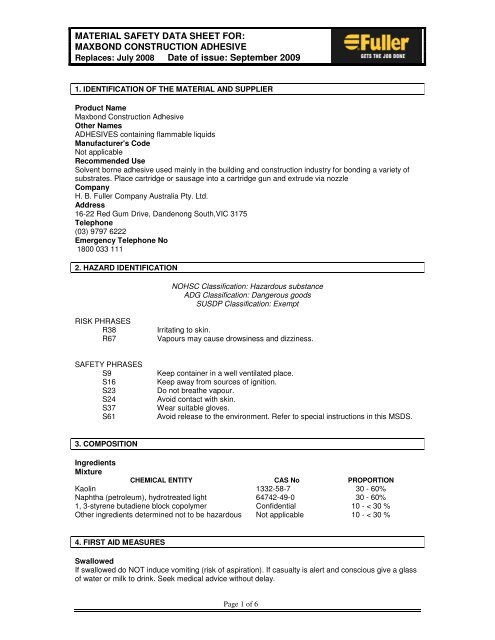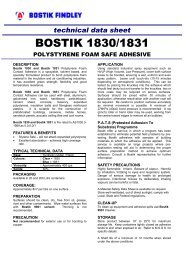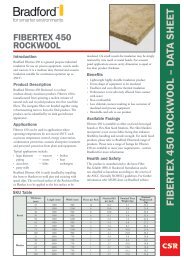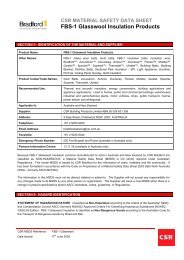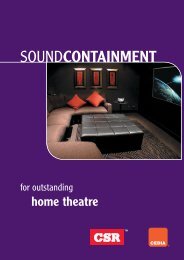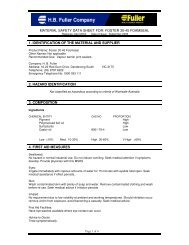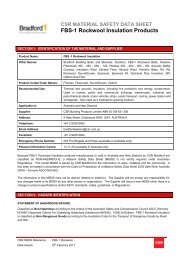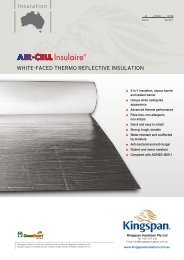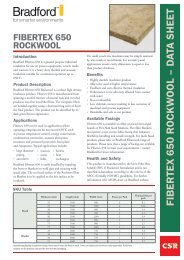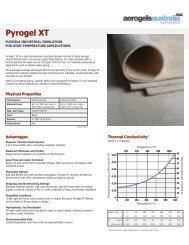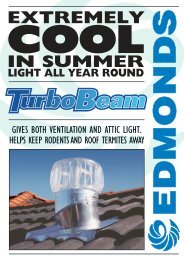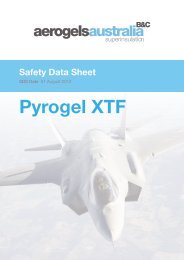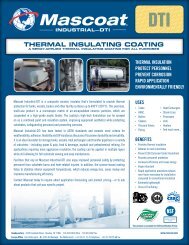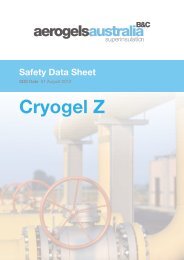Maxbond MSDS - Insulation Industries
Maxbond MSDS - Insulation Industries
Maxbond MSDS - Insulation Industries
You also want an ePaper? Increase the reach of your titles
YUMPU automatically turns print PDFs into web optimized ePapers that Google loves.
MATERIAL SAFETY DATA SHEET FOR:<br />
MAXBOND CONSTRUCTION ADHESIVE<br />
Replaces: July 2008 Date of issue: September 2009<br />
1. IDENTIFICATION OF THE MATERIAL AND SUPPLIER<br />
Product Name<br />
<strong>Maxbond</strong> Construction Adhesive<br />
Other Names<br />
ADHESIVES containing flammable liquids<br />
Manufacturer's Code<br />
Not applicable<br />
Recommended Use<br />
Solvent borne adhesive used mainly in the building and construction industry for bonding a variety of<br />
substrates. Place cartridge or sausage into a cartridge gun and extrude via nozzle<br />
Company<br />
H. B. Fuller Company Australia Pty. Ltd.<br />
Address<br />
16-22 Red Gum Drive, Dandenong South,VIC 3175<br />
Telephone<br />
(03) 9797 6222<br />
Emergency Telephone No<br />
1800 033 111<br />
2. HAZARD IDENTIFICATION<br />
NOHSC Classification: Hazardous substance<br />
ADG Classification: Dangerous goods<br />
SUSDP Classification: Exempt<br />
RISK PHRASES<br />
R38<br />
R67<br />
Irritating to skin.<br />
Vapours may cause drowsiness and dizziness.<br />
SAFETY PHRASES<br />
S9<br />
S16<br />
S23<br />
S24<br />
S37<br />
S61<br />
Keep container in a well ventilated place.<br />
Keep away from sources of ignition.<br />
Do not breathe vapour.<br />
Avoid contact with skin.<br />
Wear suitable gloves.<br />
Avoid release to the environment. Refer to special instructions in this <strong>MSDS</strong>.<br />
3. COMPOSITION<br />
Ingredients<br />
Mixture<br />
CHEMICAL ENTITY CAS No PROPORTION<br />
Kaolin 1332-58-7 30 - 60%<br />
Naphtha (petroleum), hydrotreated light 64742-49-0 30 - 60%<br />
1, 3-styrene butadiene block copolymer Confidential 10 - < 30 %<br />
Other ingredients determined not to be hazardous Not applicable 10 - < 30 %<br />
4. FIRST AID MEASURES<br />
Swallowed<br />
If swallowed do NOT induce vomiting (risk of aspiration). If casualty is alert and conscious give a glass<br />
of water or milk to drink. Seek medical advice without delay.<br />
Page 1 of 6
MATERIAL SAFETY DATA SHEET FOR:<br />
MAXBOND CONSTRUCTION ADHESIVE<br />
Replaces: July 2008 Date of issue: September 2009<br />
Eyes:<br />
If in eye, irrigate immediately with plenty of water for15 minutes with eyelids held open. Seek prompt<br />
medical advice.<br />
Skin:<br />
Remove contaminated clothing and footwear. Wash affected areas with soap and plenty of water<br />
immediately. Decontaminate footwear and wash contaminated clothing before reuse. Seek medical<br />
advice if adverse symptoms develop.<br />
Inhaled:<br />
Move casualty to fresh air. If breathing but unconscious, place casualty in the recovery position. If<br />
breathing has stopped apply artificial respiration. If a pulse is absent give external cardiac<br />
compression. Seek medical advice immediately.<br />
First Aid Facilities:<br />
Have eyewashes, safety showers and normal wash room facilities available in the vicinity where<br />
exposure may occur<br />
Advice to Doctor<br />
No specific antidote - treat symptomatically. Inhalation of vapours causes CNS depression. Check for<br />
possible aspiration into lungs<br />
5. FIRE FIGHTING MEASURES<br />
Extinguishing Media<br />
This substance is flammable. Use alcohol resistant foam, water spray or fog, dry chemical or carbon<br />
dioxide<br />
Hazardous combustion products<br />
Carbon dioxide, carbon monoxide, flammable vapours/gases of unknown composition<br />
Precautions for Firefighters<br />
Containers may explosively rupture in a fire; therefore keep containers cool with water spray. Wear full<br />
protective equipment for a chemical fire including a self-contained breathing apparatus. The vapour of<br />
this product is heavier than air and will travel considerable distances. An ignition source within its range<br />
may ignite the vapour and flash back along the vapour trail potentially initiating an explosion. Prevent<br />
fire fighting medium from entering drains or waterways.<br />
HAZCHEM Code<br />
3Y<br />
6. ACCIDENTAL RELEASE MEASURES<br />
Special protection<br />
Wearing full PPE (see Section 8); isolate hazard area and restrict access. Increase ventilation.Remove<br />
all sources of ignition. Dyke spill to minimise environmental damage. Inform emergency services if<br />
substance has spilled into sewers, drains or waterways.<br />
Small Spills:<br />
Introduce good ventilation and remove ignition sources. Wear eye protection and<br />
suitable gloves and wipe up spills with rags/squeegee. Place the recovered material in a<br />
suitable waste disposal container. Seal the container and label it in accordance with the NOHSC<br />
labelling code to ensure proper disposal. Wash wipe-up medium and spill area with a suitable nonflammable,<br />
low toxicity solvent.<br />
Large spills:<br />
Prevent run-off into drains or waterways. Wearing full protective equipment (see Section 8), contain<br />
spill with earth, sand, Vermiculite or containment socks. Take precautionary measures against static<br />
discharge. Using flameproof and non-sparking equipment to bail or pump any free liquid into the<br />
original or similar containers and seal them. Using non-sparking implements place adsorbed material<br />
into suitable waste disposal containers and seal them. Label the containers in accordance with the<br />
NOHSC labelling code. Wash residue away with a suitable non-flammable, low toxicity solvent. Ensure<br />
that washings do not enter drains or waterways. If contamination of sewers or waterways has occurred,<br />
inform the local emergency services.<br />
7. HANDLING AND STORAGE<br />
Page 2 of 6
MATERIAL SAFETY DATA SHEET FOR:<br />
MAXBOND CONSTRUCTION ADHESIVE<br />
Replaces: July 2008 Date of issue: September 2009<br />
Handling<br />
Practice sound industrial hygiene. Avoid breathing vapours. Wash hands before work breaks and<br />
at the end of a shift. Avoid skin contact. Minimise exposure by always wearing the recommended<br />
personal protection equipment (See Section 8) when handling this mixture. Do not smoke in the work<br />
area. Work only in a well ventilated area. Take precautionary measures against static discharge<br />
Storage<br />
Store in a cool (< 30ºC), dry place away from heat sources and out of direct sunlight. Keep<br />
containers closed, securely sealed and protected against physical damage when not in use. This<br />
substance is Class 3 flammable liquid and must be stored according to the dictates of<br />
AS/NZ 1940.<br />
8. EXPOSURE CONTROLS / PERSONAL PROTECTION<br />
An Australian exposure standard for this mixture has not been set by NOHSC However, an<br />
Australian exposure standard for the major hazardous components of this mixture have been set<br />
by NOHSC as shown below<br />
Exposure Standard [HSIS Jun08)] TWA STEL<br />
Naphtha (petroleum), hydrotreated light (Supplier’s<br />
1400 No data<br />
recommendation)<br />
mg/m3<br />
Toluene 50 ppm 150 ppm<br />
n-Heptane 400 ppm 500 ppm<br />
1,3-butadiene monomer 10 ppm No data<br />
Styrene monomer 50 ppm 100 ppm<br />
Biological Limit Value<br />
Not applicable<br />
Engineering Controls<br />
Good general dilution ventilation. Use local exhaust ventilation if vapours are produced. Ensure that<br />
ventilation is sufficient to control exposure levels below exposure standards.<br />
Personal Protective Equipment<br />
Use personal protective equipment that minimizes skin and eye contact, and vapour inhalation.<br />
The type of protective equipment to be used depends largely on the volume and the manner in which<br />
the mixture is used. To ensure proper protection for any given situation, seek guidance from the<br />
following sources: protective clothing – AS 2919; gloves – AS 2161; eye protection – AS 1337;<br />
respiratory protection – AS 1715; feet protection – AS 2210. The suitability of each PPE for use with<br />
this substance should then be ascertained with the respective PPE suppliers.<br />
Under condition of ordinary use, wear safety glasses with side shields, nitrile rubber gloves, long<br />
sleeved overalls, and impervious boots. In unusual situations such as a large spill or if working in<br />
confined spaces, or if vapours are generated and their airborne concentration is unknown wear, in the<br />
addition to the above, a full-face AS/NZ 1716 compliant cartridge type respirator with a suitable organic<br />
vapour filter (for selection guidance see AS/NZ 1715). If the normal, ordinary work environment<br />
necessitates the use of respiratory protection, and the respirator is the sole means of respiratory<br />
protection, use a full-face air supplied respirator.<br />
9. PHYSICAL AND CHEMICAL PROPERTIES<br />
Appearance:<br />
Thick beige paste<br />
Odour:<br />
Paraffinic<br />
pH:<br />
Not applicable<br />
Vapour Pressure:<br />
6-7.7 kPa at 20°C (Naphtha (petroleum), hydrotreated light)<br />
Vapour Density:<br />
3.52 (Air = 1) (Naphtha (petroleum), hydrotreated light)<br />
Page 3 of 6
MATERIAL SAFETY DATA SHEET FOR:<br />
MAXBOND CONSTRUCTION ADHESIVE<br />
Replaces: July 2008 Date of issue: September 2009<br />
Boiling Point:<br />
90-100°C (Naphtha (petroleum), hydrotreated light<br />
Freezing/Melting Point:<br />
Not established<br />
Solubility in Water:<br />
Insoluble<br />
Specific Gravity:<br />
ca. 1.07<br />
Flash Point:<br />
ca. -5°C<br />
Explosive Limits<br />
(%v/v): LEL = ca. 1; UEL = ca. 7 (Naphtha (petroleum), hydrotreated light)<br />
Ignition temperature:<br />
246 260°C (Naphtha (petroleum), hydrotreated light)<br />
10. STABILITY AND REACTIVITY<br />
Chemical Stability<br />
This material is stable under normal ambient and anticipated storage and handling conditions.<br />
Conditions to Avoid<br />
Ignition sources, hot surfaces or strong heating.<br />
Chemical incompatability<br />
Strong oxidising agents.<br />
Hazardous polymerisation<br />
Hazardous polymerization will not occur.<br />
Hazardous decomposition products<br />
Carbon monoxide, carbon dioxide and other noxious vapours, gases and solids of unknown<br />
composition<br />
11. TOXICOLOGICAL INFORMATION<br />
Health Effects<br />
Swallowed:<br />
May cause headaches, dizziness, nausea, vomiting, CNS effects and coma due to the presence of<br />
naphtha (petroleum), hydrotreated light. May cause stomach discomfort and constipation. LD 50 (rat)[<br />
Naphtha (petroleum), hydrotreated light] > 2000 mg/kg;<br />
Eyes:<br />
Direct contact with the eyes may result in moderate irritation. May cause reddening of the affected eye<br />
and lacrimation but is unlikely to cause permanent damage.<br />
Skin:<br />
May be irritating to skin contact due to the presence of Naphtha (petroleum), hydrotreated light.<br />
Irritation may produce itching, burning sensation, reddening swelling and/or blistering of the exposed<br />
area. Risk of skin absorption LD 50 (rat)[ Naphtha (petroleum), hydrotreated light] > 2000 mg/kg;<br />
Inhaled:<br />
Inhalation of vapour from the mixture may cause irritation of the nose, throat and respiratory system.<br />
Symptoms include a burning sensation, coughing and breathing difficulties due to the presence of<br />
naphtha (petroleum), hydrotreated light. Inhalation of very high concentrations of vapour may produce<br />
CNS effects due to the presence of naphtha (petroleum), hydrotreated light resulting in dizziness, lightheadedness,<br />
headache, nausea and loss of coordination. LC 50 (rat)[Naphtha (petroleum), hydrotreated<br />
light] > 20 mg/L/4 h<br />
Chronic Health Effects<br />
Repeated or prolonged contact may lead to adverse effects to the CNS and possibly the kidneys<br />
due to the presence naphtha (petroleum), hydrotreated light. This mixture is not expected to be a<br />
mutagen, carcinogen or reprotoxin.<br />
Page 4 of 6
MATERIAL SAFETY DATA SHEET FOR:<br />
MAXBOND CONSTRUCTION ADHESIVE<br />
Replaces: July 2008 Date of issue: September 2009<br />
12. ECOLOGICAL INFORMATION<br />
The ecological effect of the mixture as a whole has not been tested. The ecological information of the<br />
two major components is given below:<br />
Ecotoxicity<br />
Persistence and<br />
degradability<br />
Mobility<br />
Bioaccumulation<br />
13. DISPOSAL<br />
Naphtha (petroleum),<br />
hydrotreated light<br />
Expected to be toxic to fish,<br />
aquatic invertebrates, algae and<br />
micro organisms.<br />
“Readily Biodegradable”<br />
according to OECD guidelines.<br />
Oxidises rapidly by photochemical<br />
reaction in air.<br />
Low mobility. Floats on water<br />
and adsorbs to soil.<br />
Has the potential to<br />
bioaccumulate<br />
1, 3-styrene butadiene block copolymer<br />
The information given in this column is based on the<br />
knowledge of similar high molecular weight<br />
polymers, considered to be non-toxic and<br />
biologically inactive.<br />
Expected to be practically non-toxic to fish, aquatic<br />
invertebrates, algae and micro organisms.<br />
Not expected to be inherently biodegradable.<br />
Persists under anaerobic conditions.<br />
Floats on water. Remains on surface of soil.<br />
No bioaccumulation is expected<br />
This material and its empty containers are classified as prescribed waste and may only be disposed of<br />
in accordance with applicable State and local regulations. These regulations vary from jurisdiction to<br />
jurisdiction and hence the user is counselled to seek advice from the local authority and classify the<br />
waste before considering disposal. The disposal information given below is a general guide and does<br />
not replace the requirement of the local regulations.<br />
Disposal<br />
If possible recycle, otherwise dispose strictly in accordance with local industrial waste or environmental<br />
protection regulations. This substance may, if permitted by local authorities, be disposed of in an<br />
approved incineration facility. Send empty drums to a drum recycling organisation (ensure that the<br />
labels are legible and remain on the drums).<br />
Special precautions<br />
Do not allow this material to contaminate sewerage systems, soil, surface or ground water. The empty<br />
drums or other containers must not be reused, cut, welded drilled or subjected to a grinding operation<br />
or be stored in the vicinity of such operations.<br />
When large amounts of this product need to be disposed of the services of a registered, professional<br />
waste disposal or recycling organisation is highly recommended.<br />
14. TRANSPORT INFORMATION<br />
This product has been classified as Dangerous Goods. It must be transported, labelled and the<br />
transport vehicle placarded in accordance with the ADG Code requirements.<br />
TRANSPORT INFORMATION ADG IMDG/IMO ICAO/IATA<br />
UN Number 1133 1133 1133<br />
Proper Shipping Name ADHESIVES containing flammable liquid<br />
Class 3 3 3<br />
Subsidiary Risk None allocated None allocated None allocated<br />
Packing Group III III III<br />
Hazchem Code 3[Y] Not applicable Not applicable<br />
Page 5 of 6
MATERIAL SAFETY DATA SHEET FOR:<br />
MAXBOND CONSTRUCTION ADHESIVE<br />
Replaces: July 2008 Date of issue: September 2009<br />
15. REGULATORY INFORMATION<br />
All components of this material are registered with NICNAS and appear on the AICS. SUSDP exempt<br />
16.OTHER INFORMATION<br />
<strong>MSDS</strong><br />
Issue Number:<br />
05<br />
Changes made to the previous issue:<br />
Added Flash Point to <strong>MSDS</strong>.<br />
ACRONYMS<br />
ADG Code: Australian Code for the Transport of Dangerous Goods by Road and Rail<br />
AICS: Australian Inventory of Chemical Substances.<br />
CAS Number: Chemical Abstracts Service Registry Number<br />
CNS: Central nervous system<br />
DG: Dangerous Goods<br />
Hazchem Code: An emergency action code of numbers and letters, which gives information to<br />
emergency services.<br />
IARC: International Agency for Research on Cancer.<br />
N.O.S.: Not otherwise specified.<br />
NOHSC: National Health and Safety Commission.<br />
PPE: Personal protection equipment<br />
R-Phrases: Risk Phrases.<br />
S-Phrases: Safety Phrases.<br />
SUSDP: Standard for the Uniform Scheduling of Drugs and Poisons.<br />
UN Number: United Nations Number<br />
This <strong>MSDS</strong> summarises at the date of issue our best knowledge of the health and safety hazard<br />
information of the product, and in particular, how to safely handle and use the product in the workplace.<br />
Since H.B. Fuller Company Australia Pty Ltd cannot anticipate or control the conditions under which the<br />
product may be used, each user must, prior to usage, review this <strong>MSDS</strong> in the context of how the user<br />
intends to handle and use then product in the workplace. If clarification or further information is needed<br />
to ensure that an appropriate assessment can be made, the user should contact this company. Our<br />
responsibility for the products sold is subject to our standard terms and conditions, a copy of which is<br />
sent to our customers and is also available on request<br />
Page 6 of 6


